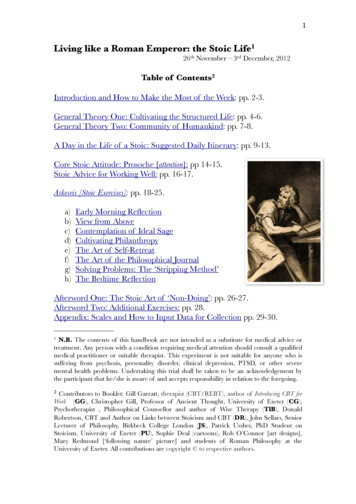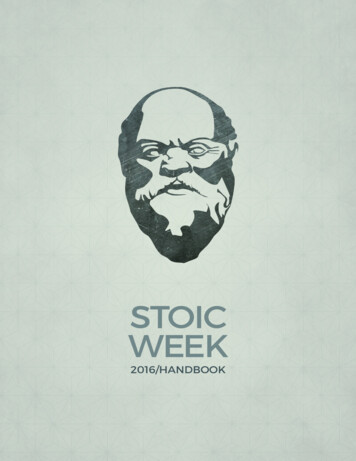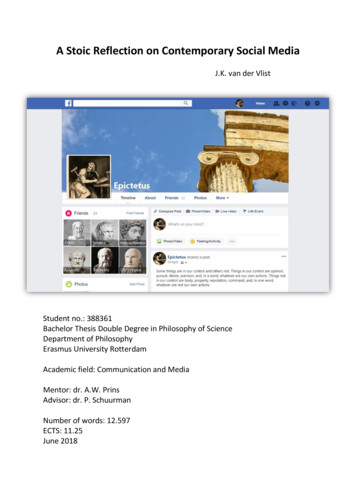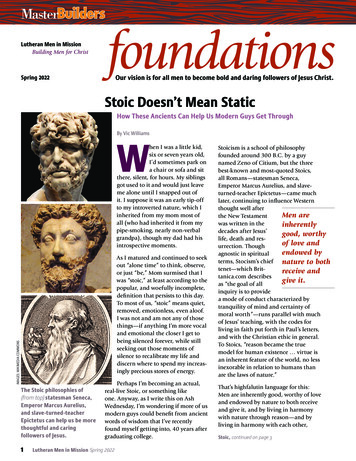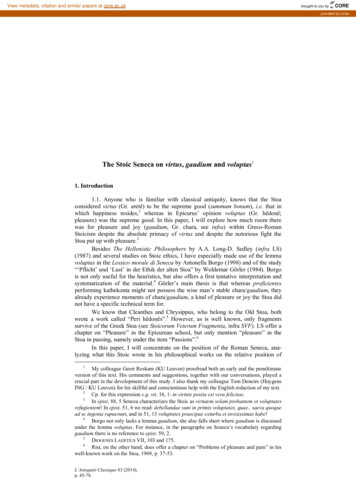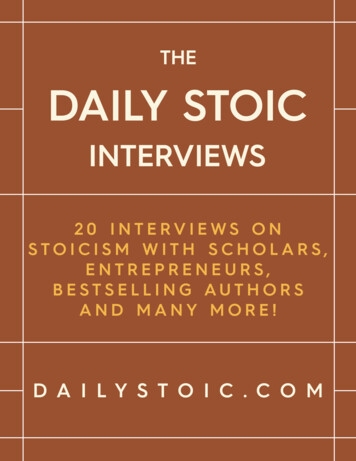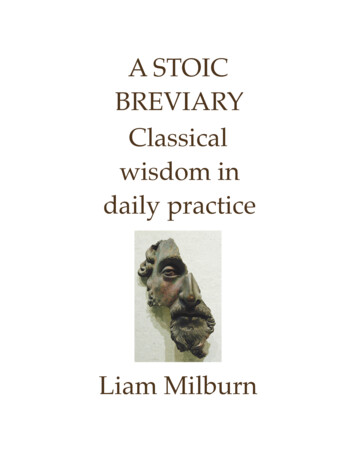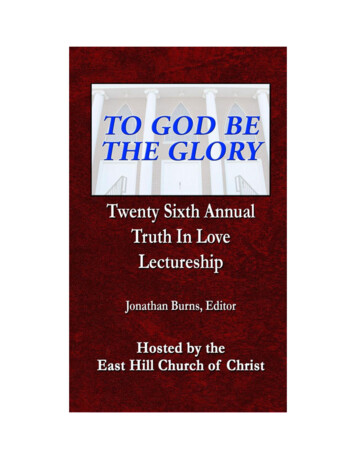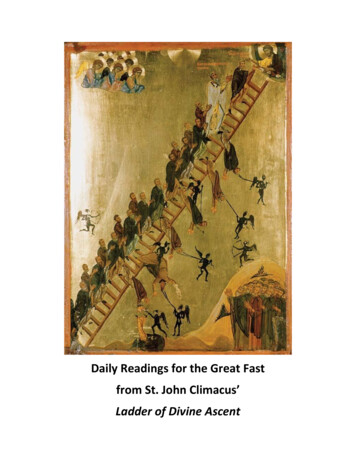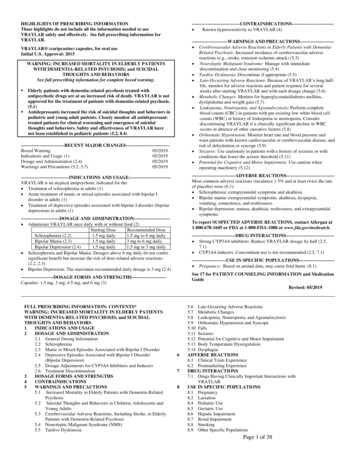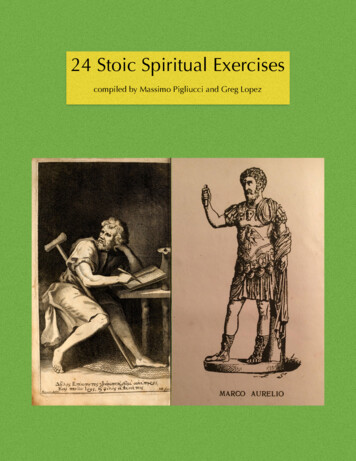
Transcription
Course Summary
ContentsDay 1Watch Today’s Sunset and Tomorrow’s SunriseDay 2Take a Cold Plunge and Shock Your SystemDay 3Find a Place of Isolation, Then Count to 1,000Day 4Pick A New Skill and Add It to Your Game This YearDay 5Visit A Part of Your City You’ve Never Been To BeforeDay 6Write Your Personal Ten CommandmentsDay 7Pretend You Have To Get a New Job — TodayDay 8Open Your Mind: Read Something by Someone You Disagree WithDay 9Find Your Most Prized Possession—and Get Rid of ItDay 10Free Yourself from One Social Media Account or News AppDay 11Go Outside and Pull WeedsDay 12Pick A Physical PR to Beat. and Re-Beat This YearDay 13Set Up Your Personal Board of DirectorsDay 14Sit Down, Write a Letter to a Friend About the New You, and Send ItDay 15Cut Out One Recurring ExpenseDay 16Today, Say Thank You ( Yes ) to EverythingDay 17Get Roasted—Learn How To Take an InsultDay 18Plan Your Perfect Day, then Make It HappenDay 19Pick Five Important Books to Re-Read This YearDay 20Start (and Fund) an Emergency ReserveDay 21Be Someone’s Hero: Do a Good DeedBonus Day :Write a eulogy 5101519 23 27 31 36 40 44 50 54 58 62 66 71 75 80 85 89 94 99
Day 1Watch Today’s Sunset and Tomorrow’s Sunrise“The day has already begun to lessen. It has shrunk considerably, but yet willstill allow a goodly space of time if one rises, so to speak, with the day itself.We are more industrious, and we are better men if we anticipate the day andwelcome the dawn.” —Seneca, Letters From A Stoic, 122.1In a beautiful letter reflecting on his “advancing years,” Seneca wrote of the comfort he tookin the fact that so many of life’s greatest pleasures are found in beginnings and endings. Theseed planted and the fruit harvested. The first day of the year and the last. The curtain opensto reveal the stage, then closes to a standing ovation.To Seneca, the ultimate example of this was the natural cycle of the Sun’s daily appearance anddisappearance. Like the first and final acts of a play, the opening and closing points of a circle,“a day has its beginning and ending, its sunrise and its sunset.”5
There are few things more pleasurable in life than watching a gorgeous sunrise or a beautifulsunset. To wake up when it’s still dark out, sitting in the quiet that’s only possible when therest of the house is asleep, watching the night creep into the day. Then, after a long productiveday, sinking into your favorite chair on the porch and watching the day fall into night as theSun sets over the horizon.Your challenge today is to observe this cycle: watch the sunset this evening, then get upbefore dawn and watch the Sun rise tomorrow. (Or if you got this email in time, watchtoday’s sunrise and sunset—literally the dawn of a new year.)Go ahead right now and Google the times for sunset and sunrise. Set alarms so that you don’tforget. Identify a place with a clear view of the western horizon. Then, when the Sun setstonight, be outside, ready to witness it all. Take in the beauty of the last light, as it ripplesacross the horizon and the Sun stains the sky above it with colors that feel like they don’t existanywhere in nature other than here in this moment. Pay attention as the bottom of the Sunreaches the horizon. It’s shocking how quickly it disappears from view; one of the most significant cosmic events visible from our Earth, over in a few minutes.Tomorrow, be sure to wake up nice and early as your spot on earth swings back around in itsrotation and the Sun prepares to make its reappearance. Get your coffee set up tonight so thatyou can have a steaming mug ready to take outside with you when the predawn darkness begins to lighten into that steely cobalt gray color that we only used to see in our younger dayswhen we hadn’t gone to sleep yet.Like the hundreds of visitors who flock to the top of Haleakalā Crater in Hawaii everymorning to witness one of the world’s great sunrises, make sure you’re situated when thosefirst bright rays peak up out of the eastern horizon and quickly turn the sky from purple toblue to red to orange. Take note of all the ways the sunrise affects your senses: The silence ofnight giving way to the emerging bustle of dawn. The smell of the crisp air, so cold in partsof the Northern Hemisphere it almost burns your sinuses. The feel of your skin beginningto equalize with the air temperature and your body beginning to emerge from its nightlydormancy.Observing this cycle is an important practice, especially to kick off this year’s challenge.It combines the symbolic with the practical and it brings you up close to a primordial process of renewal and rejuvenation—two things that we want you to experience during thischallenge.It’s not just the coming and the going of the day’s light that is so important to absorb, physically. It’s also the symbolism of the cycle itself—one day finished, a new day born, one yearfinished, one year beginning—which is a key to unlocking the perspective we want to cultivate for the months to come.6
You see, 2019 is gone. It’s dead and buried. It’s in the past and it won’t be coming aroundagain. And yet, because we don’t pay attention to this kind of cycle in its daily form, we allowourselves to let one year—sometimes whole decades—bleed into the next as if they are all thesame thing, just as we do with our days.This is part of the reason it’s so easy to get stuck on the petty resentments of yesteryear and failto make any personal progress as a result. How many of us fixate on past failures, or continuebasking in the glory of last year’s successes? How often does it “feel like it was just yesterday”that all this stuff happened? Because in our minds it has been, and we’ve stagnated as a result.The times of stagnation are over and done.We want you to see the Sun set on today, and know that just as January 1st is over, just as 2019is over, so too is the you that existed for that year, for that whole decade. Forget what WilliamFaulkner said, at least for the moment; for you, the past is dead. It is in the past. And that’swhere you’re leaving it.Beautiful sunrises and sunsets happen literally every day; yet how often have you taken thetime to witness them? We want you to become the kind of person who is able to stop andsmell the roses, the kind of person who can appreciate the beauty that is all around us and findjoy in the stillness of a quiet morning or the anticipation of night.Of all the reasons we hear for why waking up early, alongside the Sun is so important—successful people all seem to do it, it builds momentum for the rest of the day—Senecaidentified the best reason 2,000 years ago: we should do it for the delight of getting to witnesslife’s greatest beginning. Indeed, taking time out of your busy schedule to watch an extendedsunset, then waking up nice and early to see the Sun rise the next day, is a great way to beginactually forming the new you.And the scientific benefits of waking up early only serve to reinforce that notion. It produces: ower risk of depression: Researchers from the University of Colorado BoulderLand the Channing Division of Network Medicine at Brigham and Women’sHospital studied how sleep and waking preferences affected the wellbeing of32,470 participants. The study, published in the Journal of Psychiatric Research,found that “late risers” were more likely to become depressed than those whowoke up earlier each day. reater positivity and proactivity: Biologist Christoph Randler conductedGa study of 367 college students to assess the correlation of sleep schedule andproactivity—a trait he previosusly linked to better job performance, greatercareer success, and higher wages. He found that morning people are moreenergetic and able to take action to change a situation to their advantage.7
“The fascinating thing about our findings,” Randler said, “is that duration ofsleep has nothing to do with the increased proactivity and morning alertnessthat we see among morning people.The timing of sleep does.” ealthier eating habits and increased health: A random trial of 2,000 peopleHconducted by researchers from The Obesity Society compared “morning types”and “evening types” and found that morning types eat a more balanced diet,make better food choices, stick to regular meal times, and eat less often—allcontributing to lower rates of obesity, lower risk of heart disease, and lower riskof diabetes.As you watch the Sun set and rise, try to take Plato’s view just as Marcus Aurelius did. Zoomout! The world, he said, is in a constant state of rebirth and recreation. Everything is cyclical; the same things happening over and over again through the eons of history. “Whateverhappens has always happened,” Marcus Aurelius wrote, “and always will, and is happening atthis very moment, everywhere. Just like this.”2019? It’s old news, it’s one for the history books. The things that bothered you about it? Pettyand insignificant. Dots in the distance. Just as the Sun sets on each day, leaving it behind, youneed to do the same with last year—because 2020 promises to demand all of your attentionand focus. However you feel about 2019, whatever you accomplished or failed to do, whateverfortunes the year brought your way: leave it all behind.“Counting even yesterday,” Seneca wrote, “all past time is lost time.” All past time is in thesame place, he said. It all sits in the same abyss. It’s done. Finished. Gone. Any time spentthinking about the past only piles up more lost time at the bottom of the abyss.It’s impossible to move forward confidently while you’re looking back over your shoulder.That’s how you run into walls and walk right off cliffs. That is no way to start a new year. TheSun’s coming up again tomorrow, shining for the first time on a fresh new day. And it canshine on a fresh new you, as well—if you let it.8
Additional Resources: leepyti.me — Plug in the time you have to wake up to see the sunrise andSSleepyti.me will tell you the optimal time to go to sleep, based on the 90-Minute Rule Letters From A Stoic, 12: On Old Age ow Admiring the Sunset Changes You for the Better by Linda Wasmer AnHdrews his Is the Best Way to Lift Your Mood—You Just Have to Get Up Early toTDo It by Gina Ryder ever Let the Sun Catch You Sleeping: Why and How to Become an EarlyNRiser by Brett & Kate McKay Forget Productivity Apps: What Time Do You Wake Up? By Shane Parrish eing In Awe Can Expand Time and Enhance Well-Being from the JournalBof Association for Psychological Science The Health Benefits of Sungazing by Dr. Edward Group9
Day 2Take a Cold Plunge and Shock Your System“The body should be treated more rigorously, that it may not be disobedient tothe mind.” —Seneca, Letters From A Stoic, 8.5It’s easy to take a few seconds of cold when it’s the middle of summer. In fact, it’s refreshing.What’s harder is to seek out that bracing, bone-chilling shock in the dead of winter. It’s harderstill to make a habit of it.That’s why for our second day of the 2020 Daily Stoic New Year New You challenge, we wantyou to do something we’ve asked Daily Stoic readers to do before, something that will shockyou out of the warm comforts of modern living and, once you’ve breathed your way throughit, make you ready for anything.Our task for you today: take the cold plunge. Immerse yourself in cold water; commit tohalf a minute of discomfort; and come out the other side stronger for it.10
That’s right, the cold plunge! Just as Seneca did to begin each year, with a freezing plungeinto an icy pool. Two thousand years ago Seneca described himself as the “cold-waterenthusiast, who used to inaugurate the first of the year with a plunge into the Virgoaqueduct [the present-day Trevi Fountain].”Challenging yourself to this kind of chill doesn’t just get your blood flowing or wash youclean. This kind of shock strengthens you. The idea behind the cold plunge is simple: You’reshowing your body, you’re showing this morning, this new year, who is in charge. You’re showing everyone that you’re tough enough to handle whatever is thrown your way.It’s a simple process: Go through your usual shower routine. Take as long as you need underthe warm water—but remember, it’s not going to last forever. When you’re ready, get a timergoing on your phone for 30 seconds. Then, without giving yourself time to think it throughor anticipate the chill, crank the handle to cold!Do whatever it takes to withstand the shock; even if you have to let out a scream. Listen carefully for the timer to go off. When it does, you have permission to scramble out of your tubor shower as fast as you can.When you’re out and thinking straight again, it’s time to reflect. Think about how cold itwas and yet how after a time, your body got used to it. Reflect on how nervous you werebefore you jumped in. Didn’t the prospect of a cold shower seem to almost fill you withterror? Think about all the things that flooded your mind, all the things you’d rather havedone instead of that, given a choice. Yet in the end, you knew that it was going to be just30 seconds long—and you worked up the nerve, and you did it. You did it.All these fears we have, all these things we play up in our minds that cause us to tremble—likethe cold plunge—we quickly realize, that wasn’t so bad. “We suffer more in imagination thanin reality,” Seneca said. He understood that the cold plunge makes this observation so muchmore tangible, so much more real.Seneca’s frequent exposure to cold water even helped prepare him for a leisurely sea excursionthat went awry. In an earlier letter, he describes a trip out at sea that turned turbulent whena storm unexpectedly struck. Seneca pleaded with the ship’s captain to make for shore, but thecaptain was reluctant, explaining that the coast is even rougher in a storm, and they shouldwait it out.When they did finally head for the shore, “I did not wait for things to be done,” Seneca wrote,“as a veteran devotee of cold water, and, clad as I was in my cloak, let myself down into the sea,just as a cold-water bather should.” Seneca braved the cold ocean water and got back to land.The point of exposing ourselves to discomfort like this is not self-flagellation, or to provesomething to others. In Stoicism, we do these exercises to inure ourselves to difficulty, so that11
when life threatens us with involuntary inconveniences or forces us into scary situations, wehave no hesitation in facing them down. We can simply do what needs to be done. Becausewe know we can take it. And we should do it today, while the year is young. “It is precisely intimes of immunity from care,” Seneca said, “that the soul should toughen itself beforehandfor occasions of greater stress.”“Nothing has given me more mental confidence,” Twitter founder Jack Dorsey explained ina recent interview, “than being able to go straight from room temperature into the cold Especially in the morning, going into an ice-cold tub from just being warm in bed is—it justunlocks this thing in my mind and I feel like if I can will myself to do that thing that seemsso small but hurts so much, I can do nearly anything.”Whether it’s going to a party where you don’t know anyone, mustering the courage to introduce yourself to a potential work connection, or even jumping out of an airplane, the fact isthat challenging yourself to do uncomfortable things is a great way to grow as a person andfind capabilities you never knew you had. And there is no better place to practice this skillthan in the shower which you (hopefully) take each day.Most of us live in fear of inconvenience, of even the slightest physical discomfort. And whenwe are matched against something unfamiliar, uncomfortable, uncertain, we panic, we meltdown, we get frustrated and angry. The whole point of this shower is shock and disquietude—to teach the body and the mind an important lesson about what life is really like and who isin charge. You are training the mind to lead the body, not the other way around.When you practice pushing yourself to (and through) the point of discomfort, you grow mentally stronger, you begin to build resiliency. Everyday annoyances begin to feel less disruptive.They less frequently threaten your ability to remain in control. That’s what it means to be aStoic: controlling the things you can control, not letting menial external inconveniences derailyou.It may help to know, particularly when you meet the initial pain of the cold, the long list ofpositive benefits that will begin to accrue to you on the other side of cold exposure: I t reduces stress and boosts the immune system: Short-term whole body coldexposure has been shown to promote tolerance to stress and drastically reducethe chance of disease. Exposure to cold promotes the release of “cold shock proteins,” amino acids that have been linked to inflammation reduction, athleticrecovery, and even protection from neurodegenerative diseases. I t improves brain function and treats depression: The Department of Radiation Oncology at the Virginia Commonwealth University School of Medicineshowed that exposure to cold activates your sympathetic nervous system and12
increases the release of neurotransmitters into your blood stream. Additionally,a cold shower sends an overwhelming amount of electrical impulses to thebrain, which results in an antidepressant effect. I t increases fat loss: According to a study in Scientific Reports, cold exposureresults in fat loss as your body strives to produce heat to warm itself up. I t reduces inflammation: Studies have shown that exposure to cold inducesan anti-inflammatory response in the body, preventing damage from swollentissue. When NFL player Kevin Everett suffered a cervical fracture during agame, doctors may have saved his ability to walk with innovative cold therapytechniques, such as “[setting] the ambulance air-conditioning. at the lowesttemperature, as Everett received two liters (about two quarts) of ice-cold salinesolution intravenously.”The healing effects of a cold plunge have been known for centuries. Hippocrates, the Fatherof Medicine, prescribed cold baths and bathing in spring water to “allay lassitude” for manyof his sick patients. The Romans built bathhouses, where health-conscious citizens would sitin a hot room for as long as it took to sweat, then dive into a frigidarium, an ice-cold swimming pool. Even further back, Egyptian papyrus scrolls have been found documenting theapplication of ice on a number of patients.But put aside the health benefits for now. Seneca wasn’t plunging into the cold to strengthenhis body or improve his physical health. And neither are we. Seneca’s goal was to cultivate anundisturbable mental resilience. So too is ours. Take your cold plunge and come out the otherside a more resilient, more tested person.And if you’re feeling like an extra challenge, ask yourself: “Now that I know what the coldplunge feels like can I do it again tomorrow?” Now that I know I am made of tough stuff,am I ready for the week ahead? Or for the next year?13
Additional Resources:From A Stoic, 53: On The Faults Of The Spirit Letters How The The Ice Scientific Evidence-Based Effects of Hydrotherapy on Various Systems of the WhatDoesn’t Kill Us by Scott Carney KevinRose on Fasting, Cold Showers and Loving One’s Craft Comfort The Why GetCryotherapy Affects the Brain, the Immune System, Metabolism, andAthletic Performance by Dr. Rhonda PatrickWay of the Iceman: How the Wim Hof Method Creates Radiant,Longterm Health by Wim HofBenefits of Being Cold by James HamblinBath Benefits: How Cold Therapy Improves the Body and the Brain byKatie WellsBody from the Journal of Medical SciencesWill Make You SoftPerils of ‘Comfort Inflation’comfort will ruin your life — TED Talk by Bill Eckstromcomfortable with being uncomfortable — TED Talk by Luvvie Ajayi14
Day 3Find a Place of Isolation, Then Count to 1,000“Stop allowing your mind to be a slave, to be jerked about.” —Marcus Aurelius, Meditations, 2.2Seneca begins one of his letters describing how thrilled he is to finally have some quiet timeto himself, all thanks “to the games, which have attracted all the bores to the boxing-match.”With the gladiatorial games begun, Seneca could finally have some peace, because the citycleared out and everyone was in the stadium.As with most fleeting moments of quiet, this excitement lasted only a short while. Eventually,Seneca complains, “a great cheer comes from the stadium,” throwing him off-kilter.15
But as he struggled to concentrate, something about those athletes—and their training andskill—inspired Seneca to wonder: “[If ] the body can be trained to such a degree of endurancethat it will stand the blows and kicks,” how could the mind be toughened the same way?Modern psychology and science has proven Seneca was right. The skill of attaining stillness—something useful in school, work, and self-improvement—can be learned with adequate practice.Today’s challenge is about beginning the mental training that Seneca contemplated. Yourjob is to find a solitary place, and slowly, quietly, count to 1,000. Without distraction.Without drifting.To some of you that will sound easy. To others that seems impossibly hard.Forget that. Just go do it. The experience will be revealing.Getting to 1,000 will be a task even without distractions, so find a place free of them: No TV,no video games or computer, no cellphone, no AirPods, no anything. We want you to focusyour mind and spirit for one solid session of stillness. Without outside distractions, it will beeasier to concentrate on one thing and one thing only, but make no mistake: your mind isplenty good at creating its own distractions, so prepare yourself.Once you’re ready, don’t delay; plunge in, just like you did with Day 2’s cold plunge. Countone digit per second—which adds up to a little more than 15 minutes—and don’t rushthrough. Don’t mentally celebrate when you get through a set of 100, or when you’re halfwaythrough. Just keep going. Stay present. Stay on task. You’ll have to concentrate your mind onyour count. Concentrate on setting an even pace. Don’t make up songs to go along with yourcount, don’t whistle, don’t be antsy—seek out the stillness in your mind, the stillness thatyou’re adding to and building up with each new second of counting.What’s the point of all this? There is no point.and that is the point. This quarter of an hourwill be one of the most present fifteen minutes of your year, possibly even your life. You willhave demonstrated that you are in control. If Seneca were around, he’d envy the strength ofmind you just displayed. At that point, you can get up and go about your day, confident thatthe sense of stillness you reached, the mental toughness you built, will stay with you.Consider using this practice, or one like it, to continue your pursuit of stillness. Literal counting is great; it’s almost like using a mantra, having to concentrate on maintaining the patternlike that. But you can also just sit still in silence for a predetermined period of time.16
One of the biggest concerns Epictetus had with his students was that they couldn’t seem toremember the importance of mental poise. He observed that most people have minds that areeasily pulled in every direction. He compared this to a child surrounded by adoring adults,their attention being drawn to every new clap or snap. He said even those that understandhow powerful the mind is don’t take the time to train it.It can be so hard to sit still, to stare at a wall or a ceiling, to focus without distraction on ablank page until the words come. Epictetus couldn’t have fathomed the number of distractionswe have to contend with in modern life. Every moment of every day. This time especially, inthe beginning of 2020, a most uncertain year headed into a fraught 24/7 presidential electionin the US will be a noisy one.But the solution today is the same one Epictetus lectured to his student: quieting the mind,sitting in the present moment, cultivating stillness. And, as he said, training this essentialability doesn’t have to be rigorous. oing your morning run without bringing your headphones along to drownDout the noise—that’s mental training. Reading a book with your phone in the other room. Working on your laptop at a coffee shop, Staring at the smudge on the wall and counting to 1000.These are all practices for achieving stillness in a world flooded with noise. Where our mindsare being pushed and pulled every which way. Personal and professional problems overwhelmus. We can hardly see our desk beneath the piling papers, or hold onto our sanity as it drownsin the anxiety that results.“People look for retreats for themselves in the country, by the coast, or in the hills,” MarcusAurelius, who was hugely influenced by Epictetus’s lectures, wrote. “There is nowhere that aperson can find a more peaceful and trouble-free retreat than in his own mind.So constantlygive yourself this retreat, and renew yourself.”Remarkably, we receive this same message from the Eastern philosophers, almost identicallyso from Siddhartha: “Within you there is a stillness and sanctuary to which you can retreat atany time and be yourself, just as I can. Few people have that capacity and yet everyone couldhave it.”The mind is such an important and sacred place. We have to spend the time training it. Nothing exhaustive or extensive. Seventeen minutes is all you need.17
Additional Resources: Letters From A Stoic, 14: On The Reasons For Withdrawing From The World Letters From A Stoic, 56: On Quiet and Study Meditations, 4.3 Stillness Is The Key by Ryan Holiday When We Are Alone With Ourselves You Must Carve Out Time For Quiet BC News’ Dan Harris on Ambition, Mindfulness and Reaching Peace ofAMind How To Meditate I s silence golden? Effects of auditory stimuli and their absence on adult hippocampal neurogenesis from the Journal of Brain Structure & Function Just think: The challenges of the disengaged mind from the Journal of Science olitude: An Exploration of Benefits of Being Alone from the Journal forSTheory of Social Behavior Awareness Is A Superpower from the Rich Roll podcast 2 Little Things That Can Happen to Your Body After Just 15 Minutes of1Meditation by Denise Mann, MS ow to Be Alone: An Antidote to One of the Central Anxieties and GreatestHParadoxes of Our Time by Maria Popova18
Day 4Pick A New Skill andAdd It to Your Game This Year“Just as nothing great is created instantly, the same goes for the perfecting ofour talents and aptitudes. We are always learning, always growing. It is rightto accept challenges. This is how we progress to the next level of intellectual,physical, or moral development.” — Epictetus, A Manual For Living, p.74James Harden has led the NBA in scoring for the past two seasons. In his first ten seasons, he’sbeen named an All-Star seven times, he’s made the NBA First Team list five times, and he wasthe 2018 Most Valuable Player. Every discussion or debate over the best basketball player inthe world includes James Harden.But perhaps what is most impressive about Harden is that he refuses to use all of his successas a reason to stagnate. Like the legends who came before him—Larry Bird, Michael Jordan,Kobe Bryant—he famously commits to adding one element to his game every offseason.19
When videos went around of Harden, already a prolific shooter, shooting these bizarre onelegged fade-away three pointers during the preseason, most assumed the superstar was justmessing around. In fact, he was working. “I’m always trying to get better,” Harden explainedof the one-legged shot. “This is my 11th year, and every single year I want to get better.I don’t want to stay the same. You’ve got to find ways to keep growing.”Whether in sports, business, or life, the greats are known for how they’re al
welcome the dawn." —Seneca, Letters From A Stoic, 122.1 In a beautiful letter reflecting on his "advancing years," Seneca wrote of the comfort he took in the fact that so many of life's greatest pleasures are found in beginnings and endings. The seed planted and the fruit harvested. The first day of the year and the last. The curtain .
